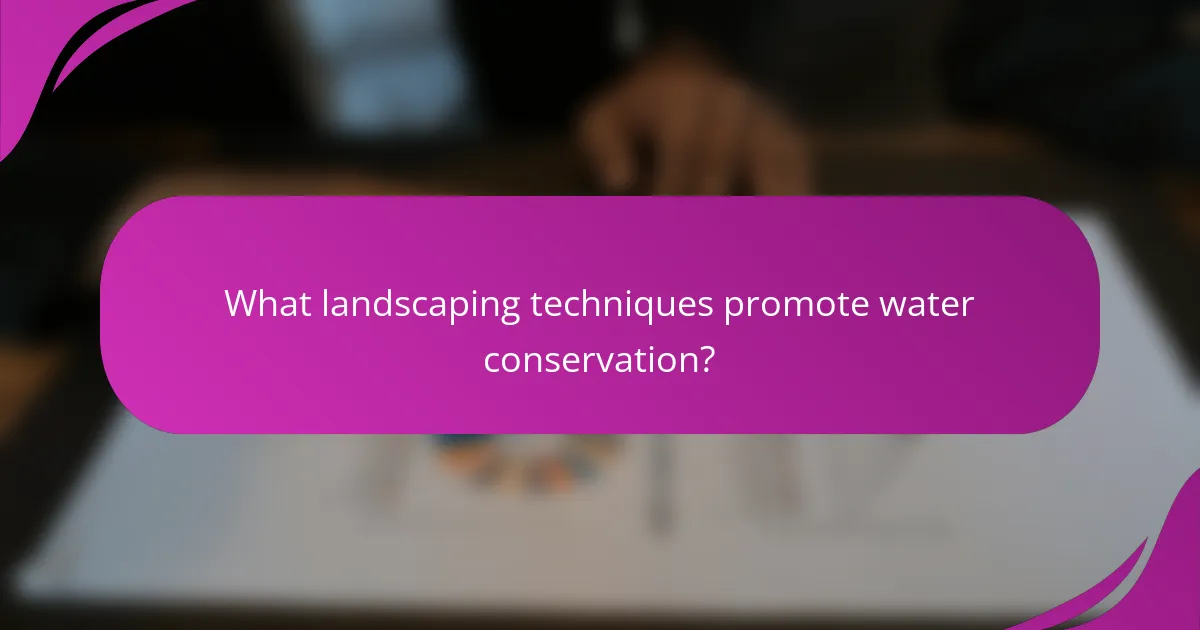Incorporating native plants into landscaping not only enhances aesthetic appeal but also promotes ecological balance and reduces maintenance needs. By selecting species that thrive in local conditions, homeowners can create beautiful gardens that support wildlife while conserving water and minimizing care requirements.

How can native plants enhance landscaping in Canada?
Native plants can significantly enhance landscaping in Canada by promoting ecological balance, reducing maintenance needs, and thriving in local conditions. By incorporating these plants, homeowners can create beautiful, sustainable gardens that support local wildlife and require less water and care.
Improved biodiversity
Using native plants in landscaping fosters improved biodiversity by providing habitats for local wildlife, including birds, insects, and small mammals. These plants are adapted to the local ecosystem, which helps maintain the natural balance and encourages a variety of species to thrive.
For example, planting native wildflowers can attract pollinators like bees and butterflies, which are essential for the health of many plants. A diverse garden not only looks appealing but also contributes to the overall health of the environment.
Lower maintenance costs
Native plants typically require less maintenance than non-native species, leading to lower long-term costs for homeowners. These plants are well-suited to local soil and climate conditions, reducing the need for fertilizers, pesticides, and extensive watering.
By selecting native species, homeowners can save on water bills and gardening expenses. For instance, once established, many native plants can thrive on natural rainfall, making them a cost-effective choice for landscaping.
Better adaptation to local climate
Native plants are inherently better adapted to the Canadian climate, which means they can withstand local temperature fluctuations, droughts, and heavy rainfall. This resilience allows them to survive with minimal intervention, making them ideal for sustainable landscaping.
Choosing plants that are native to specific regions of Canada can further enhance their adaptability. For example, plants from the Prairies will have different water and sunlight needs compared to those from coastal areas, ensuring that they flourish in their respective environments.

What are the benefits of water conservation in landscaping?
Water conservation in landscaping offers significant advantages, including reduced costs, environmental benefits, and improved soil quality. By using native plants and efficient irrigation methods, homeowners can create beautiful landscapes while minimizing water usage.
Reduced water bills
Conserving water in landscaping directly leads to lower water bills. By selecting drought-resistant plants and implementing efficient irrigation systems, homeowners can significantly decrease their monthly water expenses.
For instance, switching to drip irrigation can reduce water consumption by up to 50% compared to traditional sprinklers. This not only saves money but also ensures that plants receive the right amount of water without waste.
Environmental sustainability
Water conservation promotes environmental sustainability by preserving local water resources and reducing runoff. Native plants require less water and are better adapted to local climates, which helps maintain the natural ecosystem.
By minimizing water usage, homeowners contribute to the health of local waterways and reduce the need for chemical fertilizers and pesticides, which can pollute the environment. Sustainable landscaping practices support biodiversity and protect wildlife habitats.
Enhanced soil health
Conserving water through thoughtful landscaping practices can lead to improved soil health. When plants are chosen based on their water needs, the soil retains moisture more effectively, promoting healthy root systems.
Additionally, practices such as mulching and using organic matter can enhance soil structure and fertility. This not only supports plant growth but also reduces the need for chemical amendments, creating a more balanced ecosystem.

How to choose native plants for your landscape?
Choosing native plants for your landscape involves selecting species that thrive in your local environment, which enhances biodiversity and reduces maintenance. Focus on plants that are adapted to your region’s climate, soil, and sunlight conditions to create a sustainable and visually appealing garden.
Consider local climate zones
Understanding your local climate zone is crucial when selecting native plants. Different zones have varying temperature ranges, precipitation patterns, and seasonal changes that affect plant growth. For example, plants suited for a temperate climate may not survive in a tropical zone.
To identify your climate zone, refer to resources like the USDA Plant Hardiness Zone Map, which categorizes regions based on average annual minimum temperatures. Choose plants that are recommended for your specific zone to ensure they thrive.
Evaluate soil conditions
Soil conditions play a significant role in the success of native plants. Assess your soil type, pH level, and drainage capabilities before planting. Native plants often have specific soil preferences, such as sandy, clay, or loamy soils, which can influence their growth and health.
Conduct a simple soil test to determine pH and nutrient levels. This information will guide you in selecting plants that are well-suited to your soil conditions, minimizing the need for amendments and fertilizers.
Assess sunlight availability
Sunlight availability is another key factor in choosing native plants. Different species have varying light requirements, ranging from full sun to partial shade. Observe your garden throughout the day to determine how much sunlight each area receives.
For areas that receive full sun (at least six hours of direct sunlight daily), consider sun-loving native plants like coneflowers or black-eyed Susans. In shadier spots, opt for shade-tolerant species such as ferns or woodland wildflowers to ensure a thriving landscape.

What landscaping techniques promote water conservation?
Landscaping techniques that promote water conservation focus on reducing water usage while maintaining plant health and aesthetic appeal. Effective methods include the use of rain gardens, drip irrigation systems, and mulching, each contributing to efficient water management in gardens and landscapes.
Rain gardens
Rain gardens are designed to capture and absorb rainwater runoff from impervious surfaces like roofs and driveways. By incorporating native plants that thrive in wet conditions, these gardens help filter pollutants and recharge groundwater, reducing the need for additional irrigation.
To create a rain garden, select a location that collects runoff and dig a shallow depression. Fill it with a mix of soil and compost, then plant native species that can tolerate both wet and dry conditions. This not only conserves water but also enhances local biodiversity.
Drip irrigation systems
Drip irrigation systems deliver water directly to the plant roots, minimizing evaporation and runoff. This method is highly efficient, using significantly less water compared to traditional sprinkler systems, making it ideal for conserving resources in landscaping.
When installing a drip irrigation system, consider using a timer to automate watering schedules, ensuring plants receive consistent moisture without overwatering. Regular maintenance is essential to prevent clogs and ensure optimal performance.
Mulching
Mulching involves applying a layer of organic or inorganic material on the soil surface to retain moisture, suppress weeds, and regulate soil temperature. This practice can significantly reduce the frequency of watering needed in landscaped areas.
Choose organic mulches like wood chips or straw, which decompose over time and enrich the soil. Apply a 2-4 inch layer around plants, keeping it away from the stems to prevent rot. Regularly replenish the mulch as it breaks down to maintain its effectiveness.

How does aesthetic value impact landscaping choices?
Aesthetic value significantly influences landscaping choices by enhancing the visual appeal of a property, which can lead to increased enjoyment and property value. Homeowners often prioritize plants and designs that create a pleasing environment, balancing beauty with functionality.
Increased property value
A well-designed landscape can boost property value by a notable percentage, often ranging from 5% to 15%. Buyers are typically willing to pay more for homes with attractive outdoor spaces, as these areas contribute to the overall impression of the property.
Investing in native plants and sustainable landscaping can further enhance this value, as these features are increasingly sought after for their environmental benefits and low maintenance requirements. Consider consulting local real estate trends to understand specific impacts in your area.
Enhanced curb appeal
Curb appeal is the first impression a property makes, and landscaping plays a crucial role in this aspect. Aesthetic choices such as colorful flowers, well-maintained lawns, and strategic plant placement can create a welcoming atmosphere.
To improve curb appeal, focus on clean lines, balanced plant arrangements, and seasonal interest. Simple updates like fresh mulch or seasonal flowers can make a significant difference without requiring a large investment.
Personal enjoyment and satisfaction
The aesthetic value of landscaping directly affects personal enjoyment and satisfaction. A beautiful garden or outdoor space can serve as a retreat, providing a sense of tranquility and connection to nature.
When selecting plants and designs, consider personal preferences and how the space will be used. Incorporating elements like seating areas, pathways, or water features can enhance the experience, making the landscape not only visually appealing but also functional for relaxation and recreation.

What are the prerequisites for sustainable landscaping?
Sustainable landscaping requires careful planning and assessment of environmental factors, primarily focusing on soil quality and water resources. Understanding these prerequisites helps create a resilient landscape that conserves resources while enhancing aesthetic appeal.
Soil testing
Soil testing is essential for determining the nutrient content and pH level of your soil, which directly affects plant health. Conducting a soil test can reveal deficiencies or toxicities that may require amendments to optimize growing conditions.
To perform a soil test, collect samples from various locations in your yard and send them to a local agricultural extension office or a commercial lab. Most tests provide recommendations for fertilizers and organic amendments, helping you make informed decisions about soil management.
Water availability assessment
Assessing water availability is crucial for sustainable landscaping, as it influences plant selection and irrigation practices. Evaluate your local climate, rainfall patterns, and existing water sources to determine how much water your landscape will require.
Consider implementing rainwater harvesting systems or using drought-resistant native plants to minimize water usage. Regularly monitor soil moisture levels to avoid overwatering, which can lead to runoff and waste. Aim for a balance that supports plant health while conserving water resources.


